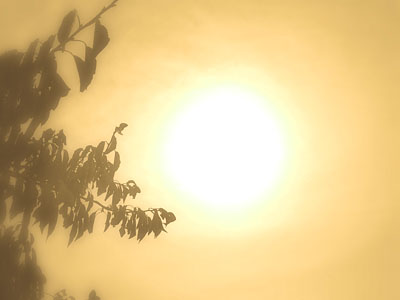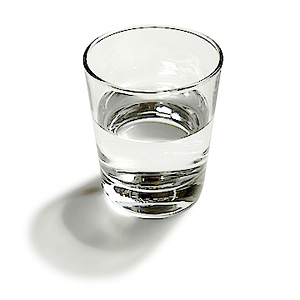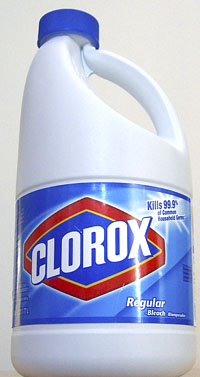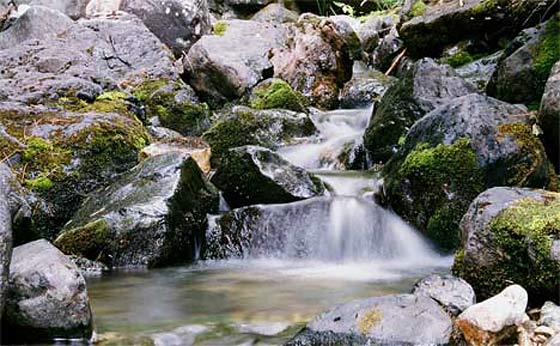Most of the information here was copied from Modern Survivalblog.com
How to Purify Water with Sunlight
Did you know that solar radiation from the sun can purify (disinfect) water and make it safe for drinking from harmful bacteria?
While so often we hear or read about the bad things that the sun is capable of doing to us, we should also know that some of the same energy from the sun can be harnessed for doing good. A few good examples include solar electric panels, solar hot water panels, and solar ovens.
Well here is one more good example. Harnessing the solar energy from the sun to purify (disinfect) water from a lake or stream into safe drinking water. It is much simpler than you may think. Here’s how…


UV-A rays from the sun, (Ultraviolet-A, longwave, 315-400 nm), will terminate harmful bacteria, parasites, and viruses in water, given enough sun exposure.
A clear plastic bottle filled with water, exposed to the sun for 6 hours will make the water safe to drink (see the caveat list). In fact, the effectiveness of terminating harmful bacteria is an amazing 5-Nines, that is, 99.999 percent!
List of germs that are terminated from UV-A sunlight exposure at 6 hours
- Bacteria – Escherichia coli
- Bacteria – Vibrio cholera
- Bacteria – Salmonella
- Bacteria – Shigella flexneri
- Bacteria – Campylobacter jejuni
- Bacteria – Yersinia enterocolitica
- Virus – Rotavirus
- Parasites – Giardia
- Parasites – Cryptosporidium (needs 10 hours exposure)
List of caveats to UV-A sunlight water purification
- This method kills germs. If the water is already contaminated with chemicals from pollution, the chemicals will remain.
- If the water is cloudy and dirty, it should be filtered first to allow the UV-A rays to effectively penetrate into the water.
- The plastic water bottle should be no bigger than 2 liters. In moderately cloudy water, UV-A will lose 50 percent effectiveness at a depth of 10 mm (about 0.5 inch), whereas UV-A will only lose 25 percent effectiveness at a depth of 10 mm in clear water. Just use a typical size soda bottle or water bottle.
How to purify water with sunlight
The recommended bottle to use is a “PET” bottle. It is very common and is typically used for soda or other soft drinks.
PET, PolyEthylene Terephthalate, Recycle code #1 on bottom of bottle.
The bottle must not be colored. It must be a clear bottle. Again, it must be a clear plastic bottle. Not glass (glass blocks too much of the UV-A for this purpose).
The bottle must be clean. Common Sense.
Know your water source (as best you can)… if you believe it to be chemically toxic, don’t use it.
Fill the bottle with water. If the water is very cloudy, it must be filtered by first pouring through a cloth or such material to capture sediment.
Lay the bottle down in the sun. Do not stand them up. Ideally the bottles would by placed so that they face the the sun at a similar angle, to maximize the UV-A penetration.
Even better… lie the bottles on a reflective surface to increase the UV-A exposure using direct and reflected sunlight. This is not necessary, however it would shorten the required time and ensure optimum UV-A exposure.
If the sky is partly cloudy with only a few clouds, then 6 hours sunlight exposure will be enough. If the sky is half filled with clouds, or more, then 2 days will be required.
Note that the outdoor temperature does not matter, so long as the UV-A sunlight exposure has been 6 hours.
A few notes:
An excellent source for more information on this subject is from the Swiss Federal Institute of Aquatic Sciences and Technology.
For those that are concerned about using plastic, the WHO (World Health Organization) states that the limiting values (plasticizers) for drinking water are never exceeded when using PET bottles for this method.
Sediment or other particulate matter should be removed first by a filtering process.
Make Drinking Water Safe with Bleach
Water. We can’t live without it. Not for long – only about 3 days. In fact, water is the one thing that we need the most, to survive.
The general rule for storing water for an emergency or disaster is 1 gallon per person per day.
There are variations to this generality, ranging from a half gallon to as much as 3 gallons per person per day because there are other uses for water besides just drinking.
————————–
A problem that you will encounter during an emergency or disaster is not only obtaining water to drink, but treating it to make the water safe to drink.
The best way to treat water for drinking is to boil it first, for one minute.
According to the Wilderness Medical Society, water temperatures above 160° F (70° C) kill all pathogens within 30 minutes and above 185° F (85° C) within a few minutes. So in the time it takes for the water to reach the boiling point (212° F or 100° C) from 160° F (70° C), all pathogens will be eliminated, even at high altitude.
————————–
If boiling is not possible, another effective way to make water safe to drink is to add a specific amount of regular household bleach. Depending on brand or concentration, regular household bleach contains between 5.25 and 8.25 percent available chlorine (liquid sodium hypochlorite), which will disinfect the water if added in the right amount.
————————–
How to purify water with Bleach
If the collected water to be treated is cloudy and contains sediment, either scoop a new sample with less sediment, or strain it first through a makeshift filter (cloth bandana, t-shirt, coffee filter, etc..) or let it sit in the container allowing sediment to settle to the bottom. Gently pour off the clearer water on top.
Use regular liquid household bleach (any brand); however the only active ingredient should be sodium hypochlorite. Do not use bleach that contain soaps, perfumes, or dyes. Be sure to read the label.
Add 8 drops (almost one-eighth U.S. teaspoon) of regular liquid bleach per one gallon of water to be treated.
Mix thoroughly and let stand for 30 minutes (important).
Then, smell the water. If the water has a faint smell of chlorine, then it is okay to use. If you cannot detect any chlorine odor, add another 8 drops of regular liquid bleach. Let stand, and smell it again. If you still cannot smell chlorine, discard it and find another water source.
Chlorine test strips are useful to verify the chlorine level in the water. The maximum safe level for drinking water according to the EPA is 4 ppm (parts per million).
Note that bleach has a shelf life, although you will probably not see a date on the bottle. Chlorine bleach may lose 20% to as much as 50% effectiveness within a year, so be sure to date your bottle upon purchase.
Notes about chlorine level for safe drinking water
The EPA recommends a maximum (no more than) 4 ppm (parts per million) of chlorine for safe drinking water.
A typical municipal water supply measured at the home faucet is typically between 0.2 and 0.5 ppm chlorine.
It takes 45 minutes to destroy Giardia Protozoan (common cause of diarrhea) with 1 ppm chlorine level.
‘CDC’ instructions for safe drinking water with bleach:
From the CDC, Centers for Disease Control, “If you don’t have clean, safe, bottled water and if boiling is not possible, you often can make water safer to drink by using a disinfectant, such as unscented household chlorine bleach”
Add 1/8 teaspoon (or 8 drops; about 0.625 milliliters) of unscented liquid household chlorine (5–6%) bleach for each gallon of clear water (or 2 drops of bleach for each liter or each quart of clear water).
Add 1/4 teaspoon (or 16 drops; about 1.50 milliliters) of bleach for each gallon of cloudy water (or 4 drops of bleach for each liter or each quart of cloudy water).
Stir the mixture well.
Let it stand for 30 minutes or longer before you use it.
Store the disinfected water in clean, disinfected containers with tight covers.
Let it stand for 30 minutes or longer before you use it.
Store the disinfected water in clean, disinfected containers with tight covers.
‘WHO’ instructions for safe drinking water with bleach:
From the WHO, World Health Organization, “Chlorine is commonly available to households as liquid bleach (sodium hypochlorite), usually with a chlorine concentration of 1%”
Disinfection with chlorine is the most appropriate way of ensuring microbiological safety in most low-cost settings.
At least 30 minutes contact time should be allowed after the chlorine is added to the water before the water is drunk, to ensure adequate disinfection. The free chlorine residual (the free form of chlorine remaining in the water after the contact time) should be between 0.5 and 1.0 mg/l (0.5 ppm and 1.0 ppm).
Water Clarification And Purification
To get safe drinking water may require a process of clarification and then purification.
Here are the details including water filtration and various methods to purify water…
WATER CLARIFICATION
Water foraged from natural sources is often contaminated with dirt, debris and suspended particles. Water should be clarified before placing it into the water filter or purifying it by other methods.
Settling:
Settling is the easiest method for clarifying and removing debris and suspended particles from the water. If the water is muddy or murky, settling it before filtering will extend the life of the filter. To let water settle merely let it stand in a large container, totally undisturbed for 12 to 24 hours. This will allow any sediment (including radioactive particles) to sink to the bottom. A handful of clay soil in each gallon of water will help speed this process. After settling is complete, pour, dip or siphon the clean water into another container, being careful not to stir up the sludge at the bottom.
Can Filters:
Clean a large can (#10 or a large juice can, etc.), and using a nail, punch several holes in the bottom of the can near the center (avoid making holes near the edges of the can). Place an inch or two of washed, crushed charcoal in the bottom of the can (purchased at any pet shop or taken from a fire). Cover the charcoal with 3 or 4 inches of glass wool or polyester aquarium filter. In an emergency, paper towels, toilet tissue, pieces of cloth or even dried grass will suffice. Be sure to pack the material tightly against the sides of the can so that no water can leak around it without being filtered. Suspend the can above a clean container. Pour the polluted water into the can, and allow it to drip into the clean container below. This type of filter will clarify up to 2 gallons of water per hour.
Earthen Filters:
Effective for radioactive water. Clay binds to radioactive particles. If radioactive fallout has contaminated the water supplies, earth filters utilizing clay type soil, will effectively remove the radioactive particles from the water. This method is better than distillation, ion-exchange filters, or charcoal filters for this purpose. Perforate the bottom of a 5-gallon can or wastebasket with holes punched within 2 inches of the center. Place a two-inch layer of washed pebbles on the bottom of the can. Cover the pebbles with one thickness of terry cloth towel or other porous cloth. Scrape the top 4-5 inches of soil off the ground to get below the fallout, and dig enough clay-type soil to fill the can to a depth of 8 inches, packing it tightly against the sides. Cover the soil in the can with another thickness of toweling and another one or two inches of pebbles. Suspend the can over a clean container and pour the contaminated water into the top. Clear (but unpurified) water will come out the bottom at the rate of about 6 quarts per hour.
Hose Siphoning:
Take a six to eight foot section of garden hose and push two cotton balls into the end. Place that end of the hose into a bucket or container of muddy water. Suck on the other end until water begins to come through. Place the free end of the hose into another container placed below the muddy container. Gravity will pull the water from the higher container into the lower container while trapping the sediment in the cotton balls and allowing only clear water to flow through the hose. When the cotton balls become clogged, simply remove them and replace with clean ones. This filter will clean approximately one quart of water in thirty minutes. However, if the water is very muddy, the cotton balls will have to be replaced very frequently.
Capillary Siphoning:
This filtration method will eliminate most particles and silt from the water. Elevate a container of polluted water above another container and run a piece of braided yarn, strips of cloth (cotton works best), or terry-cloth towel between the two containers as a filtering medium. It helps to soak the material in clean water first, to get the process started. Dirt and debris will not be pulled into the filter, but will remain in the top container. Clean water will pass through the medium and drip into the container below. Capillary action filters are quite effective, but are very slow, clarifying only about one cup of water per hour.
Coffee Filters:
Coffee filters are an excellent filtering medium. Place three or four of them (one inside the other) into a mason jar and let the edges protrude over the rim of the jar. Screw on a jar ring to hold them in place and pour the muddy water into the filters. The water will pass through the filters and drip into the jar. When the filters become clogged, simply replace them. This type of filter will clarify approximately one quart of very muddy water in two hours.
WATER PURIFICATION
After the water has been clarified, it is ready for step #2, purification. Water should not be consumed until it has been purified.
Boiling:
Water sterilization by boiling is preferred over ANY method of chemical disinfection, because disease-causing microorganisms cannot survive the heat from a sterilizing boil. If the water is cloudy, heat sterilization is the only method that can be fully relied upon to assure complete destruction of these organisms. These organisms can “hide” by burrowing into the microscopic particles that cause cloudiness in water, thereby escaping the action of disinfecting chemicals, and remaining capable of producing disease. Water that is boiled vigorously for five minutes will usually be safe from harmful bacterial contamination. One additional minute should be added for each 1,000 feet of altitude. The use of a pressure cooker (bring the water up to 15 pounds and then remove from the source of heat), conserves the most amount of fuel, if that is a concern. This guarantees that all bacteria, protozoa, and viruses have been killed. To improve the taste of boiled water, add a little charcoal from the fire to absorb odors. Pour it back and forth between two clean containers to mix the water with air.
Chemical Sterilization:
Regardless of the method of chemically disinfecting water, always double the dosage amount if the water is not absolutely clear. If the water temperature is cold (below 45 degrees), wait one hour to allow the disinfectant to work before drinking the water.
Iodine Tablets:
Iodine tablets in the form of tetraglycine hyperiodide are very effective against all forms of bacteria. This form of iodine, however, is less effective against the dreaded protozoa, GIARDIA LAMBLIA. Iodine tablets are sold in sporting-goods stores under the names of Coghlan’s Globaline, and Portable Aqua. Iodine tablets usually have a relatively short shelf life (losing 20% of their effectiveness in just six months). They are also very sensitive to heat and light. They turn color from grey to yellow as they become less potent. The usual dose is one tablet per quart of clear water, and two tablets for cloudy water. Let the water stand for 30 minutes before using.
Tincture of Iodine:
A 2% solution of tincture of iodine, as found in most first-aid kits, can be added to polluted water. Use 32 drops of tincture of iodine per gallon of clear water, or 8 drops for a quart, and let it stand for 30 minutes before using. Double this amount if the water is cloudy.
Chlorine:
Hypochlorite must be the ONLY active ingredient in liquid household chlorine bleach intended for use in purifying water. Do not use granular or powdered forms of household bleach, as they are poisonous!! Add 2 drops of liquid bleach per quart of clear water, 8 drops per gallon, or one-half teaspoon for five gallons (approximate). Double this amount if the water is cloudy. Liquid bleach loses strength over time, and in just one year of storage the dosage must be doubled to be effective. Two year-old bleach must not be used. It is not potent enough to kill disease-causing bacteria. After adding the proper amount of bleach to the water, stir and let stand for 30 minutes before drinking. Liquid bleach will kill most common forms of bacteria, but it is totally ineffective against GIARDIA and other hardy forms of protozoa.
Halazone Tablets:
Halazone tablets, the least effective method of chemically disinfecting polluted water, are available at most drug and sporting goods stores. If used, add four tablets per quart of clear water, and eight tablets per quart of water clarified from muddy water. Allow the tablets to dissolve, then shake the water and let it stand for 30 minutes before drinking. The shelf life for unopened Halazone tablets is only 5 to 6 months. If they are left in an opened package,
they can lose their effectiveness within only 48 hours.
they can lose their effectiveness within only 48 hours.
Some information sourced from The American Civil Defense Association.






No comments:
Post a Comment
Please leave your thoughts, I am always looking for new ideas.